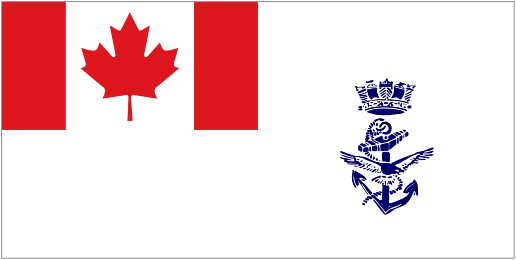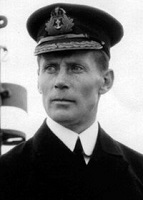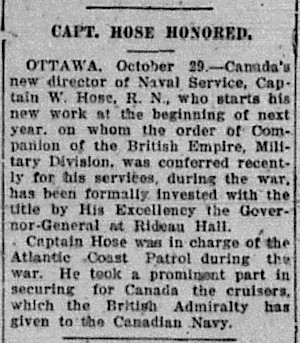|
A Royal Canadian Navy Historical Project
In memory of those who have Crossed the Bar
He was born at sea on board the P & O Steamer Surat in the Indian Ocean off Ceylon on 02/10/1875. He was the son of a Bishop of Singapore. Present in Centurion at the capture by Japan of Wei-hai-wei in China 1894. He was present in HMS Dragon in April 1897 at Crete during the Turko-Greek War. Received the China Medal for actions in the Yangtse 1900-01 during the Boxer Rebellion. In HMS Charybdis he set up and trained a Royal Naval Reserve in Newfoundland. In Venezuela, in 1904, he participated in the enforcing of payment of debts to Britain and to Release a British crew held hostage. He interdicted Afghan gun runners in the Persian Gulf while commanding Redbreast 1906, surveying pearl beds in the Gulf and received thanks of Indian Government. He was authorized for the formation of the Royal Canadian Naval Reserve and Royal Canadian Naval Volunteer Reserve in 1923. He successfully resisted the politically planned virtual disbanding of the Canadian Navy in 1933. (Source: The Nauticapedia)
By Dr. Wilf Lund, Naval Historian Rear Admiral Walter Hose is the man credited with saving the Canadian navy. During his watch as Director of the Naval Service (DNS), then as Chief of Naval Staff (CNS), 1921-1934, Hose fought many battles to ensure the survival of the fledgling RCN, in his words "the Ugly Duckling" of Canadian National Defence. Rear Admiral Walter HoseWalter Hose was quite literally "a man of the sea". Born 2 October 1875 aboard the P&O steamer Surat in the Indian Ocean, Hose, whose father was an Anglican bishop, enrolled in the Royal Navy, like many sons of clergymen. At 14, he joined HMS Britannia and spent most of the next 21 years at sea. His experience was extensive. He had six commands, including gunboats in Newfoundland and the China and East Indies Stations, and a torpedo gunboat in the Home Fleet. He also trained Royal Navy Reservists in Newfoundland from 1902-05. It was during his time in Newfoundland that he became acquainted with Captain Charles Kingsmill, the man he was ultimately to replace as Director of the Naval Service. Promotion in the RN was slow and Hose, seeking new challenges, contacted Kingsmill in 1909 regarding opportunities in the proposed Canadian Naval Service. Kingsmill had nothing to offer but they kept in touch, and when the Commanding Officer of HMCS Rainbow resigned in 1911, Hose was offered the command. He accepted, and joined Rainbow as a Commander on loan from the RN. He was also in charge of the Esquimalt Dockyard. Hose, who transferred to the RCN in 1912, worked hard to bring Rainbow up to standard for a cruiser of her class but watched as crew numbers fell until she had to be paid off in 1913 "with her belly flapping against her back-bone for want of personnel". Hose believed that the only way to win public support for the RCN was to create a citizen navy, "a naval reserve with units across the country". In 1912, he advanced this idea to Kingsmill, whose response was, "My dear Hose, you don't understand - it can't be done". A year later, during a visit to Victoria, the Minister of the Naval Service, Douglas Hazen, gave permission to a group of young men to form a naval volunteer unit and directed Hose to allow them to drill in the dockyard. Hazen also undertook to consult with his Cabinet colleagues on the idea of a naval reserve. Despite difficulty persuading Kingsmill of the merits of "Royal Canadian Naval Volunteers", Hose nevertheless pressed on, providing officers and senior ratings to conduct training for the volunteers. The support of BC's Premier Richard McBride, who was concerned about the lack of naval defence for his province, was obtained. The Governor General, the Duke of Connaught, also became interested, and Hose believed this support was critical. The Royal Naval Canadian Volunteer Reserve (RNCVR) was eventually established on 14 May 1914. Within months, Canada was at war. The only ship on the west coast deemed theoretically capable of going on the offensive was HMCS Rainbow. Two antiquated old sloops, HMS Shearwater and Algerine, and two submarines recently acquired by the province of British Columbia, were also available to provide very minimal defence. Fortunately, the Canadian government had previously directed that Rainbow be dispatched on a sealing patrol and she was thus fit for sea, if not for war. In early August, Rainbow was assigned to protect merchant shipping in the area. There was intelligence of a German cruiser squadron operating in the South Pacific and, more urgently, the possibility of two German cruisers operating off the coast of Mexico. The heavy burden of making Rainbow ready fell to Hose, who lacked both resources and support. He had no high-explosive shells onboard and only half the ship's required complement, a third of these being RNCVRs. Rainbow was dispatched on 2 August, to guard trade routes north of the Equator, with a warning that she might encounter the German cruiser Leipzig. She departed Esquimalt on 3 August; war was declared on 4 August. Rainbow became the first RCN ship ever to be at sea as a belligerent. The first month of the war was one of great uncertainty on the west coast. There were rumours of imminent attack by German cruisers. Rainbow marched and counter marched between Cape Flattery and San Francisco. She escorted Shearwater and Algerine home after they were ordered to return to Esquimalt from missions in Mexican waters, and also scouted for the German cruisers. Unknown to Hose, the Leipzig was trying to locate and engage Rainbow. They never made contact but the "what ifs" have provided grist for the history mill ever since. By the end of August, reinforcements in the form of the Japanese armoured cruiser Idzumo and modern RN light cruiser, HMS Newcastle, had arrived in Esquimalt. The German cruisers left northern waters to join German Admiral Maximilian von Spee off the South American coast, removing the threat from the North Pacific. Rainbow was assigned general patrolling duties that took Hose on one occasion as far south as Panama. He seized some German merchant ships as prizes. Rainbow also acted as a training ship for RNCVRs until paid off in May 1917. Hose, now an Acting-Captain, was reappointed in August 1917, to Sydney, Nova Scotia as Captain of Patrols responsible for Anti-Submarine Warfare (ASW) operations in the St. Lawrence area. There was a growing threat from attack by long-range German U-boats and Hose had to significantly expand patrol activities, an immense task. He approached his new tasks with characteristic vigour, but Hose had had a long war and he broke down from exhaustion. In July 1918, he wrote to Kingsmill, "The Machinery needs a rest". But the anticipated U-boat attacks materialized and Hose went back to work. By the time the war ended in November 1918, Hose had learned a great deal about the challenges to be met if the RCN was to ever become a sustainable national service. His turn to meet those challenges would not be long in coming. In March 1920, Captain Walter Hose was summoned from Halifax by the Minister of the Naval Service, the Honourable C.C. Ballantyne, and directed to immediately address the reorganization of the navy question. Hose had no experience in Ottawa and was literally thrown into the "deep end". When Hose arrived at naval headquarters, he was assigned as the Assistant to the Naval Minister and Acting Director of the Naval Service, in fact head of the RCN. It is interesting to note that Hose could be considered a middle of the pack Commander in the Royal Navy when he transferred to the Canadian Naval Service "to do something useful" and because his RN promotion prospects looked bleak. That decision was a happy one for the RCN because Hose brought to the fledgling navy traits of optimism and endurance, plus a good dose of political acumen that carried him through stormy times. A more talented and ambitious person might well have given up on the navy and sought satisfaction elsewhere. One of Hose's first tasks was to obtain ships for Canada's navy from the British Admiralty. He went to London and negotiated skillfully for a modern vessel, HMS Aurora, instead of the outmoded old coal-burner first offered (HMS Glasgow). Hose then pressed for the loan of gunnery and torpedo ratings to man Aurora. Despite fierce opposition from Britain's Second Sea Lord, Admiral Sir Montague Browning, Hose won the day. To Hose the future looked promising. HMCS Aurora with Patrician and Patriot arrived in Halifax on Christmas Day 1920. The small squadron provided a foundation to build on, plus positions for graduates of the Royal Naval College of Canada. The naval appropriation - $2.5 million - was sufficient to man and operate the ships, and on New Year's Day 1922, Hose was confirmed as the Director of the Naval Service. This good fortune was short lived. Mackenzie King's Liberals defeated the Conservatives in the fall election of 1921. The Liberals had a natural inclination toward anti-militarism and needed no coaxing to slash the military budget. Rumours circulated that the Naval Service was to be absorbed by the Militia (the newly created Canadian Air Force had already succumbed to this fate). In addition to meeting the basic challenge of finding money for the RCN's survival, Hose needed to ensure that the Navy contentcolumntained its independence. The budgetary axe fell quickly; the RCN had its appropriation cut by 40 percent to $1.5 million dollars. This compelled Hose to reduce the fleet to Patriot and Patrician and four minesweeping trawlers. He closed the Naval College and Youth Training Establishment and cut personnel down to just over 400. Walter Hose fully appreciated that the RCN had no support in the government or the country; increased funding would come only with political support. It was necessary to create "a far greater sea-consciousness." Hose believed; "The navy must be brought into the country(...)." The only way to do this was to raise a naval volunteer reserve with units in populous cities throughout the Dominion. From this vision the Royal Canadian Navy Volunteer Reserve (RCNVR) was established on 31 January 1923, with 1000 officers and men. Naval reserve divisions soon opened in fifteen cities across Canada, mostly with half companies of 50 personnel. According to historian Marc Milner, "the volunteer reserve companies were an instant success." Hose was in many ways replicating for the navy the model that had made the militia an institution of Canadian society. It worked very effectively and the base for rapid expansion was in place when war came. For years Hose continued to be plagued by political infighting but was finally named Chief of the Naval Staff in 1928. Under his watch , HMCS Skeena and Saguenay, the first two warships built for the RCN, were obtained. The two destroyers were part of Hose's long-range plan for a small fleet to meet Canada's defence requirements. Hose and the RCN were not home free yet, however. The depression forced massive cuts on the Department of National Defence. In May 1933, the Government called for a $3.7 million cut in the defence budget ($2 million of which was to be taken from the RCN). The recontentcolumning $422,000 was insufficient even to pay for the Navy's disbandment. It was the clear objective of the Militia to abolish the Navy. The Chief of the General Staff, Major General Andrew McNaughton, had personally recommended this to Prime Minister Mackenzie King on the grounds that if the Government could not afford to contentcolumntain all three services efficiently, then the Navy should be done away with. Hose recalled, "Naturally I steadfastly opposed this, (...) and I was able to leave them with the final estimates I had submitted - intact." This was Hose's final battle. He requested to be permitted to retire and recommended that Commander Percy Nelles succeed him as Chief of the Naval Staff. Hose was promoted to Rear Admiral on the retired list in June 1934. Rear Admiral Walter Hose probably saved the Royal Canadian Navy. His legacy was a small but vibrant, enthusiastic and highly professional regular force. Across Canada the divisions of the RCNVR wove the Navy into the fabric of Canadian society. Hose was at heart a tenacious fighter but also a political realist. Had it not been for Hose the RCN, the "Ugly Duckling of Canadian National Defence", may not have survived. (Source: Restore the Honour)
Ships served in: HMS BRITANNIA HMS HYACINTH HMS IMPERIEUSE - Served in Imperieuse in 1891 as a Naval Cadet RN HMS CENTURION - Appointed to Centurion 01 Mar 1892 as a Midshipman, RN HMS CALYPSO - Served in Calypso in 1895 as a Midshipman, RN HM Torpedo Boat 44 - Appointed to HM Torpedo Boat 44 on 01 Aug 1896 as SLt, RN, Commanding Officer HMS SKATE - Served in Skate in 1896 as SLt, RN HMS POLYPHEMUS - Served in Polyphemus in 1897 as SLt, RN HMS DRAGON - Served in Dragon in 1897 as SLT, RN HMS TWEED - Appointed to Tween, a River Gunboat in China, in 1899 as Lt, RN, Commanding Officer HMS JUPITER - Served in Jupiter in 1901 as Lt, RN HMS CHARYBDIS - Served in Charybdis as Lt, RN in 1901 HMS RINGDOVE - Served in Ringdove in 1905 as Lt, RN, Commanding Officer HMS KALE - Served in Kale in 1905 as Lt, RN, Commanding Officer HMS REDBREAST - Served in Redbreat in 1906 as Lt, RN, Commanding Officer HMS JASON - Served in Jason in 1908 as Lt, RN, Commanding Officer HMS COCHRANE - Served in Cochrane in 1908 as Cdr, RN, Commanding Officer HMCS RAINBOW - Served in Rainbow 24 Jun 1911 - 30 Apr 1917 as Cdr, RN, Commanding Officer. 2nd Commanding Officer ** Retired from the RN - 01 Feb 1912 // Appointed Capt, RCN 01 Jan 1916 HMCS STADACONA - Appointed to Stadacona in 1918 as Capt, RCN, Add'l as Captain of Patrols HMCS SEAGULL - Served in Seagull in 1918 as Commanding Officer
Article on Capt Hose being awarded Companion of the British Empire (C.B.E.) The Morning Chronicle, Saturday 30 Oct 1920 Researched by é Courtesy of George Newbury
|
 For Posterity's Sake
For Posterity's Sake 


